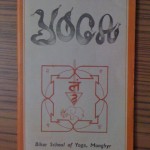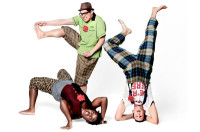By guest author Nanditha Ram, author of Blissful Mom, Blissful Baby
I recently read an article in The New York Times about the dangers of yoga entitled How Yoga Can Wreck Your Body.
Let me play devil’s advocate for a second and say, “yes, it can”. Indeed, anything taken to the extreme, has the seeds of the opposite sown in it. And so it is with yoga too. Too much of a good thing…
Still, the very idea that yoga is dangerous is preposterous.
That said, the way in which we practice an age old science can contribute to it being a boon or a bane, so the responsibility lies on the practitioner and the teacher.
I have been practicing yoga regularly for nearly two decades now and have taught for almost as long and I have neither experienced an injury myself nor have I had any one of my students report a yoga injury.
Now let’s get down to basics. What is yoga?
It is a way of life at best and a tool for wellness at worst, depending on what one wants out of it. So this leaves one with the question:
How much responsibility is one willing to take for one’s own body?
Any tool has to be used correctly in order to get the desired result. If not, there are consequences to be faced. Either way, this calls for introspective awareness on the part of the user. No point blaming the tool when things go awry.
Yoga has become a distorted fitness program with the idea that anyone who ever so much as got on that mat must be flexible, fighting fit and sexy. This is a big impediment to the practice and teaching of yoga.
Classical yoga is never taught in a way that makes the body feel bruised or abused.
It is a gentle, deep acting wellness path that paves the way for one’s evolution as a human being. In fact, the term “yoga injury” is so alien to authentic yoga teachings, that the fact that it has found a place in common parlance is disconcerting to say the least.
Every asana or in fact every yoga practice, is contraindicated for certain states of body and mind. This is the warning sign that practitioners are not meant to ignore.
Yoga is an esoteric science and a sacred art from an ancient civilization. It has now become a multi-billion dollar commodity worldwide and what is more, anybody who teaches yoga gets the title “yogi”.
I think yoga injuries come from forgetting to be present.
So if you have what you think is a yoga injury, then stop abusing your body and start practicing yoga. It is not about striking the perfect pose or getting it perfectly right – because that could end up being a royal pain in the asana. It is about getting into your own skin and feeling well in it.
Yoga is not an endurance test or a test of your ego. It is about letting go, breathing easy, accepting, and embracing the moment as it is. Never hold an asana for longer than the body says it can. Listen to the body, for it will tell you what it needs and more importantly, what it doesn’t need.
My much-loved and very wise yoga teacher used to say that yoga is the art of listening. He also taught us that the practice of yoga was 50% breath observation and 50% common sense!
And finally, here is a note to the aspiring yoga practitioner: Do yourself a favour and don’t learn yoga from books, and for heaven’s sake, evaluate your teacher like your life depends on it, because just maybe, it does.
About Nanditha Ram:
 Nanditha Ram is a yoga teacher and has trained for several years in India under astute masters. She is a consumer awareness and health writer, and a qualified holistic therapist. She currently teaches yoga in Karori, Wellington and is the mum of two gorgeous children who started their yoga practice in the womb. Nanditha likes the crazy and the quirky aspects of human nature and loves that yoga brings out everybody’s best wild self.
Nanditha Ram is a yoga teacher and has trained for several years in India under astute masters. She is a consumer awareness and health writer, and a qualified holistic therapist. She currently teaches yoga in Karori, Wellington and is the mum of two gorgeous children who started their yoga practice in the womb. Nanditha likes the crazy and the quirky aspects of human nature and loves that yoga brings out everybody’s best wild self.
Her prenatal yoga book “Blissful Mom, Blissful Baby” is currently available on Amazon.com and her blog can be read at www.bindumandalayoga.blogspot.co.nz


Having just screwed my rotator cuff doing apparently well-taught Chaturangas, your argument strikes me as facile as it is delusional.
Hi AgentPete,
Thanks for your comment and sorry to hear about your injury. We need to evaluate what we are meant to learn from such experiences. What do we want from our yoga practice? This is a question for all yoga practitioners to mull over everytime, before stepping onto the mat, because yoga is NOT the sum total of asana and pranayama. The body holds emotions and memories. When we release muscle in yoga, we also release some of these emotions. We let go. Injuries may happen when we are not present with the body or when we try to push it beyond what it is ready for – either unintentionally or due to poor guidance. Awareness and presence is key. This is the reason why enlightened yogis recommend we start where we are and rise from there.
I wish you speedy recovery and the right kind of yoga under the guidance of a qualified yoga therapist could even help the healing process.
Hey Pete,
Well-taught is one thing, but your body may not have been ready for Chaturanga. And that’s the tricky thing about yoga, especially when it’s taught in group classes. There needs to be a certain amount of movement for postures to work safely, but as a teacher, it’s difficult to assess everyone in a class and provide them with the appropriate modified instruction for their body. I have no idea if that is what happened in your case or not. It’s one potential.
I cringe sometimes when I see what’s going on in shoulders and elbows when I teach downward dog in a group class. I almost don’t want to teach it anymore – there’s always at least one or two people who don’t have the degree of openness required to do the posture safely. They need modifications to work into it properly. Ditto with Chaturanga. It’s difficult – weight-bearing and all, and potential for injury is high.
Is it the yoga?
Or is it the application of yoga?
Or are we merely splitting hairs?